- Home
- Painting Daylilies
Start Painting Daylilies with a Step-by-Step Watercolor Tutorial
More watercolor flowers, painting daylilies is a good winter project.
Summertime is such a wonderful time to be outside in the garden. Tending and enjoying the beautiful flowers and the joys of gardening.
It's January now with no gardening, so why not paint watercolor flowers. There are no pink daylilies in my garden, but here are some pretty pink "January Daylilies".
What a joy! Enjoy painting your daylilies.
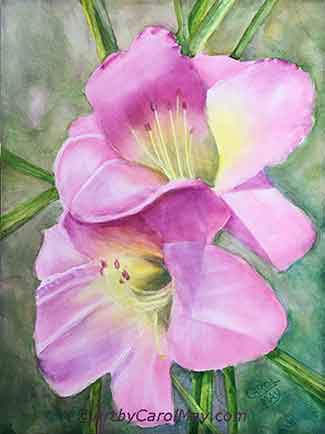 "January Daylilies"
"January Daylilies"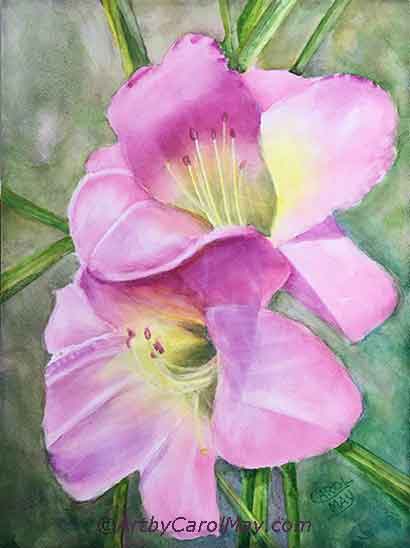 "January Daylilies"
"January Daylilies"What Do You Need for Painting Daylilies?
First we need something to paint. Paint from either some live flowers or a good photo.
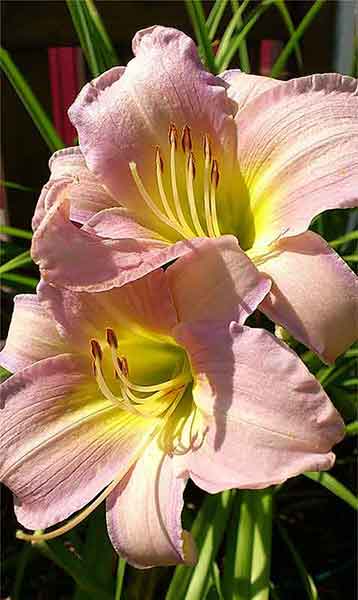 Reference Photo
Reference PhotoSince it was January when this painting was done, there we no live flowers. This excellent photo was like a ready-made composition.
Second you need brushes and something to paint on. I used a couple of round watercolor brushes, plus a script liner.
My favorite watercolor support is Aquabord. This painting is a 9"x12", but you can make it any size you wish.
This daylily painting is done with tube watercolor paints, pan watercolors will work just fine.
- Permanent Rose
- A primary yellow, like Winsor Yellow
- Viridian Green
- Quinacridone Violet was added for the shadows.
Start Painting Your Daylilies with a Drawing
Sketch the daylilies on your painting surface. Or do a drawing on paper and transfer it with graphite paper.
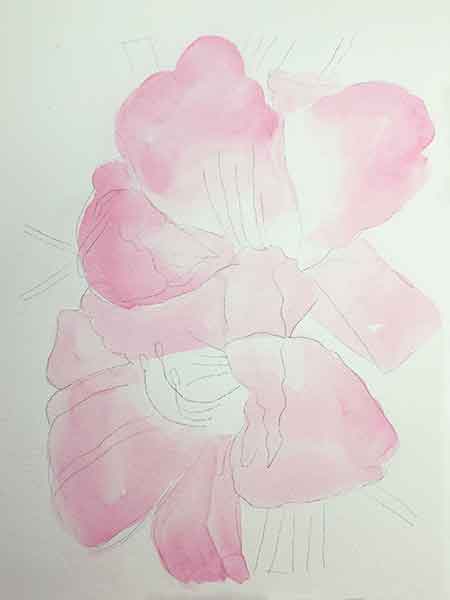 Start painting with Permanent Rose.
Start painting with Permanent Rose.Just beware that erasing on the watercolor surface, especially on paper may damage the surface.
The damaged surface will take the paint differently.
Prewet a petal and start painting in the Permanent Rose.
If you
want a warmer pink, mix the rose with some yellow to warm up the color.
Start painting on the end of the petal you want darker. Pull the paint toward the lighter area of the petal.
Leave the center of the flowers unpainted.
Use your artistic sense. Do whatever is pleasing to you.
While painting daylilies or any other subject, there is no absolute right or wrong way to do things.
Paint the Yellow Centers
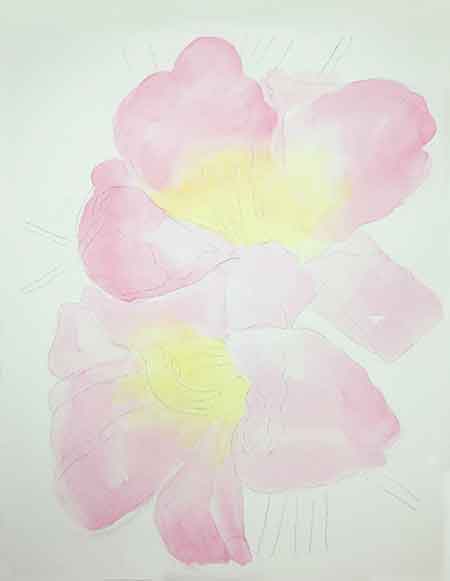 Paint the yellow centers.
Paint the yellow centers.Let the pink dry before you paint the yellow centers.
Prewet the centers and a little way over the pink.
Paint the yellow from the center out.
Feather the edge of the yellow out over the wet area on top of the pink. This allows the yellow to softly merge into the pink.
Let the yellow dry.
You may want to use a hair dryer to speed up the dry time.
Every artist has their own methods and you will develop your skills according to your own taste.
Just enjoy painting. That's what it's all about!
Painting the Shadow Areas
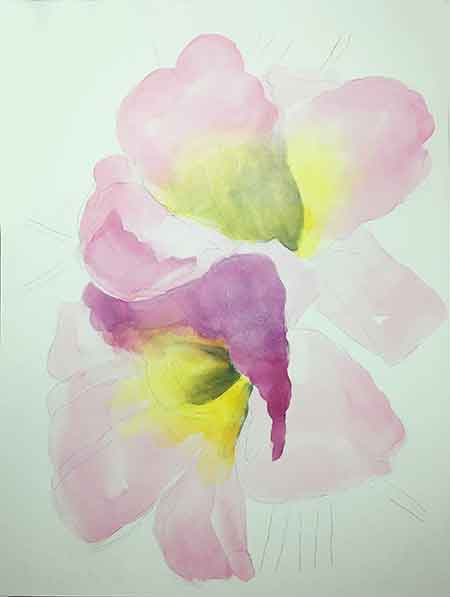 Paint the shadow areas.
Paint the shadow areas.Mix a dark from your complimentary colors, Permanent Rose and Viridian Green.
More about mixing paint colors.
Check out the reference photo to see the dark areas in the
centers.
Paint the darks from the center out, the same way you did with the yellow.
Identify the other shadow areas. I used Quinacridone Violet for the shadows.
Sometimes it was mixed with yellow to warm the color. Or sometimes mixed with the rose, so it's not so dark.
When you are painting daylilies or anything else, it's a good idea to vary your colors.
Don't have the same exact color over a large area. Give the viewer's eye more interesting things to look at.
Making Adjustments
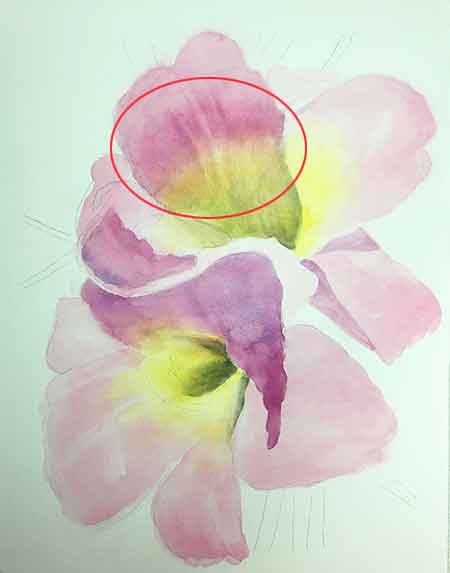 Notice the mistake
Notice the mistakeGlaze over the pink areas you want to intensify.
While making the dark area of pink across the top petal, it turned out to be a straight line.
It cut off the center part of the yellow.
The yellow should arch up in the center and down on the sides.
So how was it fixed?
After the paint was dry, some of the yellow paint was stroked off on the sides of the petal with a flat, damp brush.
After two or three strokes, rinse the paint out of the brush. Blot the excess water out of the brush before stroking again.
Let the area dry before painting on it again.
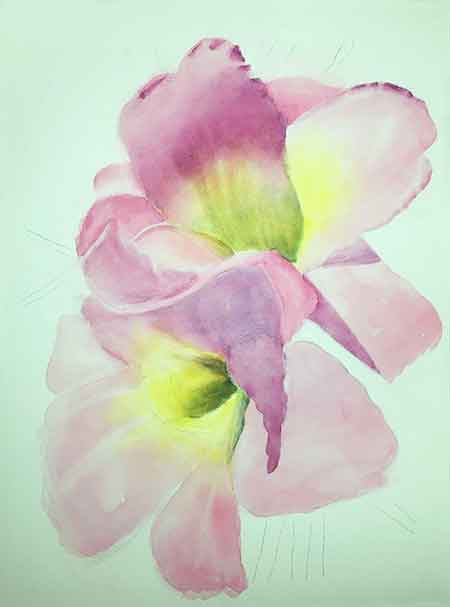 Paint all the remaining petals.
Paint all the remaining petals.Continue painting the petals.
Notice now the yellow is going higher up on the center of the petal.
Indicate some shadow areas on the edges of some of the ruffled petals.
If you do it only on the top daylily, it will keep the viewer's eye higher up in the painting.
The dark purple shadows attracted too much attention away from the rest of the flowers.
So I lifted some of the shadow areas with a damp brush.
Finish painting the remaining petals.
The underpainting is ready for the final painting with details.
Refine and Detail
After all the petals were painted, it looked too confusing.
If it was confusing to me, it certainly would be to the viewers. Especially since the viewers don't have access to the reference photo.
So, I combined several petals into one. It looked simpler and less confusing.
We artists have the option of changing things around when we are painting daylilies or anything else. That's why it is a painting, not a photograph. We get to improve on nature.
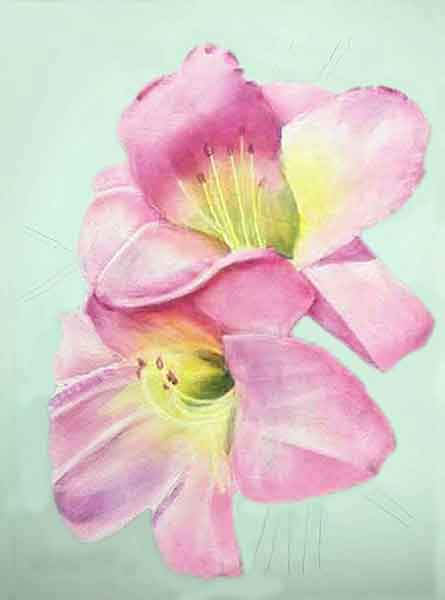 Indicate some veins on some petals.
Indicate some veins on some petals.Put some light shadows on the petals of the bottom daylily to indicate veins.
It's time to paint the stamens. When you are painting daylilies, the stamens are an important part of daylily identity. You may do the stamens in one or two ways.
- Either take the edge of a damp flat bush and pull out a place for the stamens and then paint them.
- You may use some Titanium White to paint the stamens on top of the existing colors. Mix a little yellow with the white to warm it up. Then stroke the stamens on with a script liner brush.
- A third option would be to use masking fluid on the stamens before you start painting daylilies. Remove the masking fluid after the petals are dry. Then paint the stamens.
How to retain the white of watercolor paper.
Paint the anthers with a bit of Permanent Rose dulled with Viridian.
Choose Your Background Color
A light grey background would work. Mix a light grey from the pink and green. Using more or less pink or green gave some variation of colors in the background.
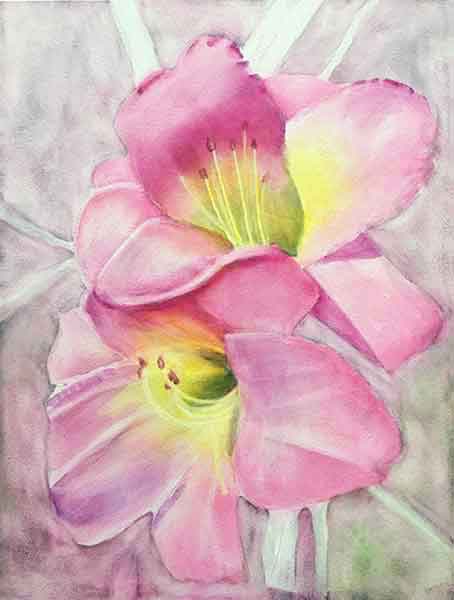 Start painting the background.
Start painting the background.Use plenty of water on the background to wet it before you paint. That way you will prevent hard edges.
A Second Background Choice
The complimentary color of pink/red and green is a good choice to show off the flowers.
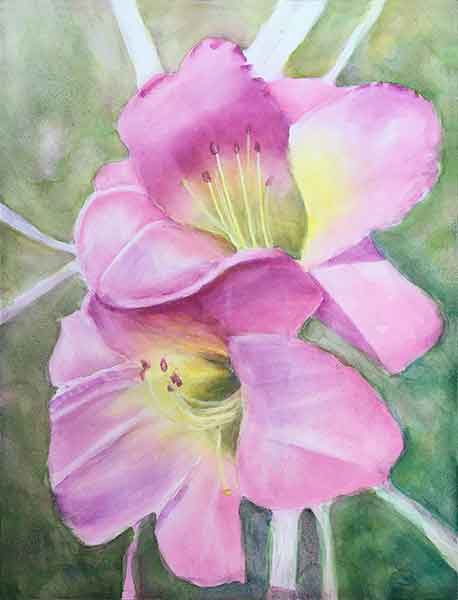 Green compliments the pink flowers.
Green compliments the pink flowers.Paint the background darker at the bottom and lighter toward the top of the painting. This helps to ground the painting and indicates sunlight.
Use the Permanent Rose to dull the greens. Yellow adds some nice warm variations.
Paint the Leaves
Mix a variety of greens with more or less yellow and more or less water. Remember to dull the greens with the rose color.
Daylilies have a lot of leaves. So when you are painting daylilies you can put in as many leaves as you want.
Put the leaves wherever you want. Nature is full of variety.
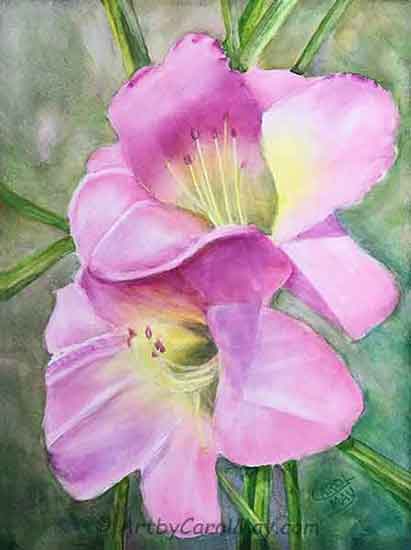 Paint the leaves with a variety of greens.
Paint the leaves with a variety of greens.





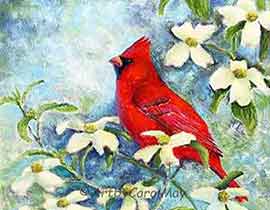 How do we create a focal point in art? Where do we put the focal point? How do we find the focus of an artwork? Should all paintings have a center of interest or can they have more than one? Learn fro…
How do we create a focal point in art? Where do we put the focal point? How do we find the focus of an artwork? Should all paintings have a center of interest or can they have more than one? Learn fro…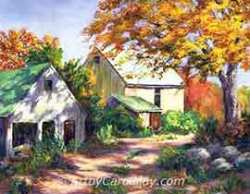 Art elements and principles appear over and over in good paintings. The elements and principles work together for us to create successful artwork. Art principles are the rules that govern how an artis…
Art elements and principles appear over and over in good paintings. The elements and principles work together for us to create successful artwork. Art principles are the rules that govern how an artis…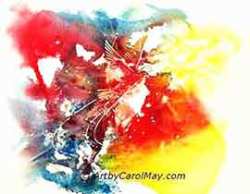 Artists often use the meaning of color to convey emotions, sentiments, and symbolism. Are you intrigued by the idea that colors can enhance or suppress different aspects of your paintings? Let's look…
Artists often use the meaning of color to convey emotions, sentiments, and symbolism. Are you intrigued by the idea that colors can enhance or suppress different aspects of your paintings? Let's look…